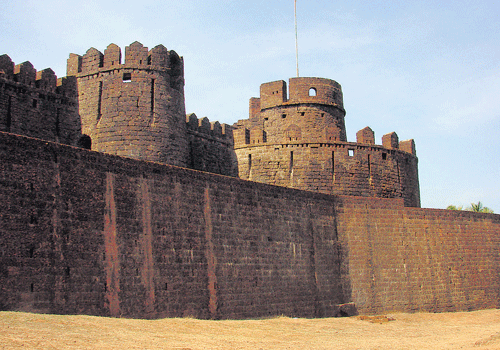
Home to an age-old fort that stands majestic even today, Mirjan is a testimony to the time gone by, writes Chitra Ramaswamy.
There is a quiet calm about the fort that was once known for its architectural grandeur and had enjoyed its days of glory and was also the seat of several battles. Travelling along the scenic west coast of Karnataka, we journey back in time, to at least five hundred years ago when we come across Mirjan Fort.
The Fort, for us is an unscheduled halt on our way to Karwar. A history and travel buff, ever on the lookout for spots off-the-beaten track, I get our driver to veer off the serpentine highway on seeing a sign indicating Mirjan. Located on the banks of the Aganashini River, a tributary of the Sharavathi, Mirjan Fort is about 11 km from the town of Kumta.
Regal ruins
The Fort, a red laterite structure stands regal even in ruins, on a little promontory against the background of verdant hillocks. The Fort itself is impressive, spread over 11.8 acres. The double-walled citadel boasts a unique blend of Islamic and Deccan architectural styles with high walls and bastions from which stands out one tall, square-shaped crumbling turret. It is obvious from historical records that there must have been a few more turrets, reminiscent of Portuguese military architecture of the times.
Since we are here on a weekday, the Fort has few visitors besides us and we are able to savour its beauty in peaceful silence. A circular moat runs around the periphery of the fort and is believed to have been ridden with crocodiles in the bygone eras – as the first line of protection against enemy attack. The waterway also enabled transportation of merchandise to the nearest harbour.
We enter the structure through its main entrance, flanked by huge bastions with steeply sloping bases and broad steps. In addition to this main entrance, the Fort has three subsidiary entrances, all of which have broad steps leading to its interior and are interconnected. All these have access channels leading to the circular moat that once circumscribed the fort, and leading to the canal works outside the fort’s limits.
Spices in demand
A local caretaker doubles up as guide and accompanies us, reeling out myths and facts associated with the Fort. History points to Mirjan being one of the significant micro ports on the Konkan coastal belt which served as an export base for the assortment of spices and precious stones produced in the flourishing Vijayanagar kingdom.
The region around Mirjan was abundant in pepper cultivation and the spice was much sought after by the Portuguese, Dutch, French and British, all of whom, had trading posts here at various points in time.
Historical records point to the fact that the British even built a large warehouse in Mirjan to store pepper and sandalwood before shipping it out. The spice assumed such fame and importance that it lent its name to Queen Chennabhairadevi of Gersoppa whom the Portuguese nicknamed “Rainha de Pimenta” or “Pepper Queen”. As our guide points out to traces of what must have once been a stately durbar hall and a secret passage in the Fort complex, visions of the Pepper Queen holding court flicker before us.
From the presence of several wells inside the Fort, the routes linking these wells to the fort exterior and the canal surrounding the fort, we surmise that the waterways must have been used to ferry cargo, making the area a robust trading centre.
As we reach the top, we are in for a visual feast as the view is breathtaking, straight out of a picture postcard. The surroundings is a vast mosaic of green expanse ridden with coconut groves, paddy fields and foliaceous trees with rivulets and streams snaking their way through them.
Historical insights
The origins of the Fort are debatable as its construction is attributed to various rulers who had suzerainty over the region which has been referred to as Mirjan or Mergen by some foreign travellers.
While some sources date the fort’s construction to 1200 A.D, during the period of the Nawayath Sultanate, one of the first historical records dates the Fort’s reconstruction to Queen Chennabhairadevi of the Vijayanagar Empire in 1608.
The Queen who held her sovereignty over the region for 54 years, the longest period of reign in the history of the Fort, is believed to have been its resident for several years. It was during her reign that Mirjan witnessed flourishing trade, especially in commodities like betelnut, nutmeg, cassia and saltpeter.
Mirjan was then passed into the hands of the Bijapur Sultans and the Fort in its present state is ascribed to Sharief-ul-mulk, the governor of Goa under the Adil Shahi regime that was in power between 1608 and 1640. The Marathas seized control of the citadel in 1757 from whom the British imperialists wrenched it in 1784.
Mirjan Fort was well maintained even during the imperial rule but went into a state of neglect following India’s independence.
The ASI carried out excavations in the fort in 2001 and unearthed several laterite structures belonging to the medieval period and art objects, golden coins minted in 1652, Chinese porcelain, Islamic inscriptions and other antiques attributed to Conde De Sarzedas, the Portuguese viceroy. Dumbells, iron bullets, coins and designed earthenware pots belonging to the Sarpamallika Dynasty have also been excavated.
Some of the objects that had been dug up, lie strew under a pair of huge trees, the base of which is home to a shrine, perhaps of a local deity and other idols.
Fuzzy green moss cover substantial portions of the walls even as wild flora sprout from the crevices that also appear to be cool refuge for skinny lizards and other creatures of its ilk.
But the heartening fact is that the ASI in recent times has actively restored and renovated parts of the Fort in an attempt to preserve the heritage monument for posterity.